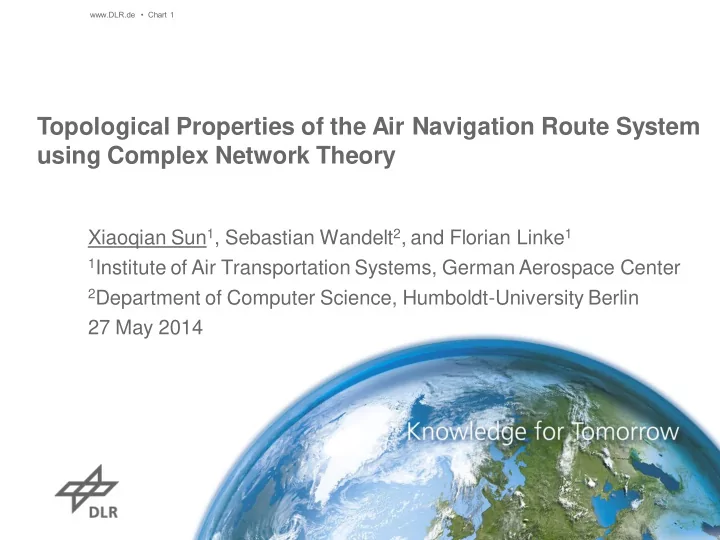

www.DLR.de • Chart 1 Topological Properties of the Air Navigation Route System using Complex Network Theory Xiaoqian Sun 1 , Sebastian Wandelt 2 , and Florian Linke 1 1 Institute of Air Transportation Systems, German Aerospace Center 2 Department of Computer Science, Humboldt-University Berlin 27 May 2014
www.DLR.de • Chart 2 Outline • Motivation • Complex air transportation systems • Background • Complex network theory • Network analysis of the air navigation route systems • Conclusions
www.DLR.de • Chart 3 Motivation: ATS as complex systems Air Transportation Systems (ATS) • Large number of system components with different characteristics . • Multiple stakeholders involved to meet ambitious goals for future ATS. Challenging Tasks • Regulate the flow of air traffic and use of airspace in a safe, cost-efficient, and environmental-friendly way. One solution: Complex Network Theory
www.DLR.de • Chart 4 Background: Complex network theory • A network : is a collection of nodes joined together in pairs by edges . E G F • Network examples: C B A H D Social network: People (nodes) linked by social interaction (edges). Airport/Airline flight network: Airports (nodes) are linked by flights (edges).
www.DLR.de • Chart 5 Two perspectives of Complex ATS: • One perspective - Airport network • Nodes : Airports • Edges : Flight connections between two airports • Weights : Number of available seats, number of flights, etc. • Another perspective - Air navigation route network • Nodes : Significant points • Edges : Route segments between two significant points. • Weights : Great circle distance, number of flights, etc.
www.DLR.de • Chart 6 Air navigation route network - an example (Germany)
www.DLR.de • Chart 7 Database- EAD European Aeronautical Information Service Database • EAD is a centralized reference database of aeronautical information using XML . • We build the air navigation route network based on the EAD, effective on 18 October 2012 .
www.DLR.de • Chart 8 Air navigation route networks for 15 countries
www.DLR.de • Chart 9 Topological properties of air navigation route networks 1) Degree 2) Distance strength 3) Weighted betweenness centrality 4) Weighted closeness centrality 5) Edge length distribution
www.DLR.de • Chart 10 Topological property 1: Degree E G F C B A H D • Degree : the number of edges connected to a node. • Node A (4) > Node C (3) > Node B (2) • In a social network, higher degree indicates more influence , more access to information , or more prestige . • Degree distribution: The cumulative degree distribution P(k) is the probability that a randomly chosen node has a degree at least k . Poisson distribution
www.DLR.de • Chart 11 Topological property 1: Degree Log-log scale Power law with cutoff
www.DLR.de • Chart 12 Topological property 2: Distance strength E G F C B A H D • Distance strength ( weighted degree ): the cumulative distances of all the connections from (or to) the considered node [Barrat, 2005]. • In the airport network • A linear behavior indicates uncorrelated random connections • A power law behavior reveals important correlation between topology and geography • Larger airports also have farther-reaching connections • Hub airports have large connectivity, large traffic, and long- distance connections.
www.DLR.de • Chart 13 Topological property 2: Distance strength Log-log scale Power law
www.DLR.de • Chart 14 Topological property 3: Betweenness centrality E G F C B A H D • Betweenness : How often a node lies on shortest paths between all pairs of other nodes in the network [Freeman, 1977]. • In this example, there are in total (7*6/2=21) pairs of nodes. • Betweeness: A (15) > B (12) > C(11) • Nodes with high betweenness have considerable influence within a network via their control over information passing between others. • Removal of the nodes with high betweenness from the network will most disrupt the flow of information between other nodes. • Betweenness is not a measure of how well-connected a node is (degree), instead it measures how much a node falls “between” others [Newman, 2010] .
www.DLR.de • Chart 15 Topological property 3: Betweenness centrality Semi-log scale Exponential
www.DLR.de • Chart 16 Topological property 4: Closeness centrality E G F C B A H D • Closeness : average distance from a node to all other nodes. • A : (4*1+2+2*3)/7=1.71 (for unweighted) • B : (1+1+5*2)/7=1.71 (for unweighted) • C : (3*1+2+3*3)/7=1.875 (for unweighted) • Nodes with lower values have better access to information at other nodes or more direct influence on other nodes. • More central nodes have lower values; while less central nodes have higher values. Thus, we take the inverse of the average distance. • We use the great circle distance as the edge weight .
www.DLR.de • Chart 17 Topological property 4: Closeness centrality Semi-log scale
www.DLR.de • Chart 18 Topological property 5: Edge length distributions Semi-log scale Exponential
www.DLR.de • Chart 19 Summary of regressions on five metrics in the 15 air navigation route networks
www.DLR.de • Chart 20 Hierarchical clustering for the 15 countries
www.DLR.de • Chart 21 Conclusions • Air navigation route networks for all fifteen countries are rather heterogeneous : most nodes have only a few connections with other nodes and a few hub nodes have a large number of connections. • Our analysis for weighted betweenness centrality shows that some countries (e.g. USA) are more robust against node failures than other countries (e.g. South Africa). • The hierarchical clustering based on the regression coefficients shows that the countries with similar network features are clustered together. Future work • Network analysis of the air navigation route system can be used to identify potential bottlenecks of air traffic in the future. For example, an air navigation node with high degree or betweenness centrality is most likely to be congested.
www.DLR.de • Chart 22 Thank you for your attention! Contact: Xiaoqian Sun Institute of Air Transportation Systems, German Aerospace Center (DLR) xiaoqian.sun@dlr.de
Recommend
More recommend